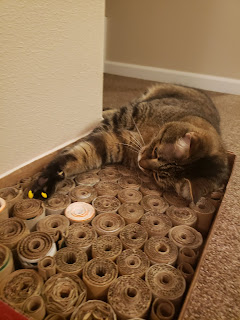Previously, I wrote about how concentrates are an eco-friendly way to move product. With all the water removed, you save lot of weight and space, and therefore need way less trips to ship more product.
I've been struggling to want to change my hair conditioner though. I have dry hair and love to use several pumps of rich, creamy lotion-like product. So while several of my low-waste social groups tout the benefits of bar-form hair products, I was hesitant to make the switch.
Last year, I learned about a company, HiBar, that was getting rave reviews and decided to give it a try.
You're left with a sizable pile of shavings.
Step 2: Pour the shavings into a large bottle. HiBar says this conditioner is as good as at least 16 ounces of regular conditioner, so I'm going for a 16+ ounce bottle. My last bottle of drugstore conditioner will do: it's 28 ounces and has an awesome pump. You want to pour the shavings in, not the finished product, because it will be that thick and creamy.
Step 3: Pour in hot water. It doesn't need to be boiling, but as hot as your tap will go. I'm starting with 16 ounces to see if HiBar delivers on its promise, but ultimately end up filling the entire 28 ounce bottle.
Step 4: Close up the bottle, give it a shake, and let it it sit for about 10 minutes. The hot water will do its job to melt down the shavings and reconstitute into a lotion. Then, compare it to your drugstore conditioner. The first picture of the yellow conditioner is my old L'Oreal conditioner, whose creaminess I wanted to match.
This second picture of blue conditioner is the HiBar. Creaminess achieved! And we exceeded HiBar's estimation that we would get 16 ounces of value - we got 28!
So now to discuss pricing. I only pay $7 for the L'Oreal conditioner. Even though I got more than expected from HiBar, is it worth the $14? It's really a false comparison to go on volume alone. HiBar boasts: "No sulfates, parabens, silicone, phthalates, and no cruelty." Compare to brands with similiar qualities, like Pacifica (8 oz conditioner for $10) or Aveda (8.5 oz conditioner for $19), and you get substantial cost savings.
Overall, I'm happy that I found a solution to conditioner that's easy on the planet, and luscious for my hair.




























